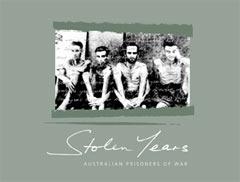Stolen Years: Australian prisoners of war
Touring Exhibition
08 November 2022 to 26 June 2005
Stolen Years: Australian prisoners of war tells the story of Australian prisoners of war - evocative, realistic, personal and often tragic - from the First World War to the Second World War and Korea.

It was a tragedy: the dying and the hating equally … but there emerged a sense of values which made the simple rich and profound.
Ray Parkin, HMAS Perth
A pilot in Turkey, a soldier in Germany, a nurse in Indonesia, a sailor in Japan: more than 34,000 Australians have endured captivity in wartime.
They spent months or years behind barbed wire. At first somewhat dazed, they were usually hungry and bored, often cold or sick; sometimes forced to work. Always under the control of their captors, many were treated badly or beaten; some tortured or killed.
Prisoners of the Japanese, the largest group by far, suffered most severely. The balance of this exhibition reflects their experience.
Captivity often confronted men and women with challenges to their self-worth. Though captivity was never a matter of choice, prisoners of war were often embarrassed by their fate. But for what they endured and how they survived, these men and women deserve our understanding, respect and admiration.
Captivity was a time when lives were interrupted, hopes put away and relationships strained. For all of them, these were Stolen Years.
Australian prisoners of war
The First World War
Portrait of a prisoner of war. "Very sincerely Eric Wright, Standal 08-08-1917
In 1914 hardly any Australians knew what being a prisoner of war meant. In the Boer War a few dozen Australians had been captured and quickly released.
During the First World War over 4,000 Australians became prisoners. Captured by the Ottoman Turks in the Middle East and by the Germans in Europe, they were the first Australians to learn about humiliation, ill-treatment, hunger and sickness in captivity. But they also learnt that they were not forgotten and that defiance, and even escape, was possible.
The 4,000 prisoners of the Great War were very few compared to the 60,000 killed and 150,000 wounded, and they remained overlooked for generations.
Second World War
risoner of war (POW) identification photograph of 410615 Flight Sergeant (Flt Sgt) John Ansell, Wireless Operator RAAF
About 8,000 Australians became prisoners of war of the Germans and Italians in the Second World War. They included airmen and soldiers of the 6th, 7th and 9th Divisions.
Most remained captive for more than three years. They endured cold, hunger and a spirit-crushing boredom. All put their lives on hold while awaiting a fate they could not control.
Over 22,000 Australian servicemen and almost forty nurses were captured by the Japanese. Most were captured early in 1942 when Japanese forces captured Malaya, Singapore, New Britain, and the Netherlands East Indies. Hundreds of Australian civilians were also interned.
Korean War
Pyoktong, North Korea, 1952-53. Propaganda photograph of POWS eating apples in the other rank POW camp, Pyoktong, in the winter of 1952-53
hirty Australian servicemen were captured by North Korean or Chinese forces in the Korean War, 1950–53.
Five men endured captivity for over two years. Flight Lieutenant Gordon Harvey was the first Australian captured, in January 1951; Corporal Don Buck, Private Tom Hollis, Private Robert Parker, and Private Keith Gwyther were captured in the first half of 1951. They endured long years of brutal treatment for their “uncooperative” attitude.
Prisoners in Korea suffered many of the same trials as those of the Japanese – neglect, hunger and brutality – but in the biting cold of a Korean winter. They also endured attacks on their minds. In a war fought between rival ideologies, “brainwashing” was used to try to turn prisoners from the cause they served.


